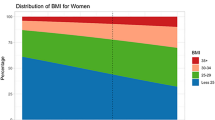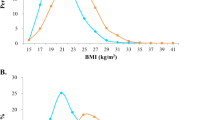Abstract
Purpose: To examine secular trends in obesity and overweight among Canadian adults between 1970 and 1992. The impact of education level and smoking on weight trends is explored.
Data: Adults aged 20–69 participating in three national health surveys which obtained measured height and weight: the Nutrition Canada Survey conducted between 1970 and 1972 (analysis sample n=5963); the Canada Health Survey of 1978–1979 (analysis sample n=3622); and the Canadian Heart Health Surveys conducted between 1986 and 1992 (analysis sample n=17 699).
Methods: Comparison of percentage overweight (age-standardized body mass index (BMI) 25.0–29.9) and obese (age-standardized BMI≥30.0) by sex, education level and smoking status across the three surveys.
Results: Among men, the proportion overweight and obese increased steadily from 1970–1972 to 1986–1992. Among women, there was a substantial increase in the proportion overweight and obese between 1970–1972 and 1978–1979, then an increase in proportion obese, but not overweight, between 1978–1979 and 1986–1992. Although the prevalence of obesity increased in all education levels, the sub-groups with the greatest relative increase are men in the primary education category, and women in the secondary and post-secondary between 1970–1972 and 1986–1992. An increase in the prevalence of obesity was greatest among current smokers and, to a lesser extent, among former smokers.
Conclusion: While excess weight has become an increasing public health problem among Canadian adults, the rate of increase in prevalence of obesity since 1970 varied with sex, education level and smoking status. There is a need for new data on measured heights and weights of Canadian adults and children and youth to update trends.
This is a preview of subscription content, access via your institution
Access options
Subscribe to this journal
Receive 12 print issues and online access
$259.00 per year
only $21.58 per issue
Buy this article
- Purchase on Springer Link
- Instant access to full article PDF
Prices may be subject to local taxes which are calculated during checkout


Similar content being viewed by others
References
World Health Organization. Obesity: preventing and managing the global epidemic Report of a WHO Consultation on Obesity WHO: Geneva 1998.
Popkin BM, Doak CM . The obesity epidemic is a worldwide phenomenon Nutr Rev 1998 56: 106–114.
Birmingham CL, Muller JL, Palepu A, Spinelli JJ, Anis AH . The cost of obesity in Canada Can Med Assoc J 1999 160: 483–488.
Macdonald SM, Reeder BA, Chen Y, Deprés J-P, Canadian Heart Health Surveys Research Group. Obesity in Canada: a descriptive analysis Can Med Assoc J 1997 157 (1 Suppl): s3–s9.
National Health and Medical Research Council. Acting on Australia's weight: a strategic plan for the prevention of overweight and obesity Commonwealth of Australia: Canberra 1997.
Flegal KM, Carroll MD, Kuczmarski RJ, Johnson CL . Overweight and obesity in the United States: prevalence and trends, 1960–1994 Int J Obes Relat Metab Disord 1998 22: 39–47.
Mokdad AH, Serdula MK, Dietz WH, Bowman BA, Marks JS, Koplan JP . The spread of the obesity epidemic in the United States, 1991–1998 JAMA 1999 282: 1519–1522.
Cairney J, Wade TJ . Correlates of body weight in the 1994 National Population Health Survey Int J Obes Relat Metab Disord 1998 22: 584–591.
Health Canada and Statistics Canada. Statistical report on the health of Canadians Prepared for the Federal, Provincial and Territorial Advisory Committee on Population Health Minister of Public Works and Government Services: Ottawa 1999.
Simmons G, Jackson R, Swinburn B, Yee RL . The increasing prevalence of obesity in New Zealand: is it related to recent trends in smoking and physical activity? NZ Med J 1996 109 (1018): 90–92.
Flegal KM, Troiano RP, Pamuk ER, Kuczmarski RJ, Campbell SM . The influence of smoking cessation on the prevalence of overweight in the United States New Engl J Med 1995 333: 1165–1170.
Boyle CA, Dobson AJ, Egger G, Magnus P . Can the increasing weight of Australians be explained by the decreasing prevalence of cigarette smoking? Int J Obes Relat Metab Disord 1994 18: 55–60.
Tienboon P, Wahlqvist ML, Rutishauser IH . Self-reported weight and height in adolescents and their parents J Adolesc Health 1992 13: 528–532.
Rowland ML . Self-reported weight and height Am J Clin Nutr 1990 52: 1125–1133.
Nutrition Canada. Nutrition: a national priority A Report by Nutrition Canada to the Department of National Health and Welfare Information Canada: Ottawa 1973.
Demirjian A . Anthropometry Report: height, weight and body dimensions A Report from Nutrition Canada Minister of National Health and Welfare: Ottawa 1980.
Health and Welfare Canada, Statistics Canada. The health of Canadians Report of the Canada Health Survey Minister of Supply and Services: Ottawa 1981.
MacLean DR, Petrasovits A, Nargundkar M, Connelly PW, MacLeod E, Edwards A, Hessel P . Canadian heart health surveys: a profile of cardiovascular risk. Survey methods and data analysis Can Med Assoc J 1992 146: 1969–1974.
Reeder BA, Angel A, Ledoux M, Rabkin SW, Young TK, Sweet LE . Obesity and its relation to cardiovascular disease risk factors in Canadian adults Can Med Assoc J 1992 146: 2009–2019.
Craig CL, Russell SJ, Cameron C, Beaulieu A . Foundation for joint action: reducing physical inactivity Canadian Fitness and Lifestyle Research Institute: Ottawa 1999.
Bennett SA, Magnus P . Trends in cardiovascular risk factors in Australia. Results from the National Heart Foundation's Risk Factor Prevalence Study, 1980–1989 Med J Aust 1994 161: 519–527.
Posner BM, Franz MM, Quatromoni PA, Gagnon DR, Sytkowski PA, D'Agostino RB, Cupples LA . Secular trends in diet and risk factors for cardiovascular disease: the Framingham Study J Am Diet Assoc 1995 95: 171–179.
Gray-Donald K, Jacobs-Starkey L, Johnson-Down L . Food habits of Canadians: reduction in fat intake over a generation Can J Publ Health 2000 91: 381–385.
Sante Quebec . Les Quebecoises et les Quebecois mangent-ils mieux? Rapport de l'enquete quebecoise sur la nutrition 1990 Sante Quebec: Quebec 1995.
Nova Scotia Heart Health Program, Nova Scotia Department of Health, Health and Welfare Canada. Report of the Nova Scotia Nutrition Survey 1993.
Acknowledgements
This work was supported in part by Health Canada.
Author information
Authors and Affiliations
Corresponding author
Rights and permissions
About this article
Cite this article
Torrance, G., Hooper, M. & Reeder, B. Trends in overweight and obesity among adults in Canada (1970–1992): evidence from national surveys using measured height and weight. Int J Obes 26, 797–804 (2002). https://doi.org/10.1038/sj.ijo.0801991
Received:
Revised:
Accepted:
Published:
Issue Date:
DOI: https://doi.org/10.1038/sj.ijo.0801991
Keywords
This article is cited by
-
Longitudinal study of variation in body mass index in middle-aged UK females
AGE (2012)
-
Explained and Unexplained Regional Variation in Canadian Obesity Prevalence
Obesity (2011)
-
Engaging Community Partners to Promote Healthy Behaviours in Young Children
Canadian Journal of Public Health (2010)
-
Overweight and Obesity among adults in Serbia: Results from the National Health Survey
Eating and Weight Disorders - Studies on Anorexia, Bulimia and Obesity (2010)
-
Examining the association between socioeconomic position and body mass index in 1978 and 2005 among Canadian working-age women and men
International Journal of Public Health (2010)



